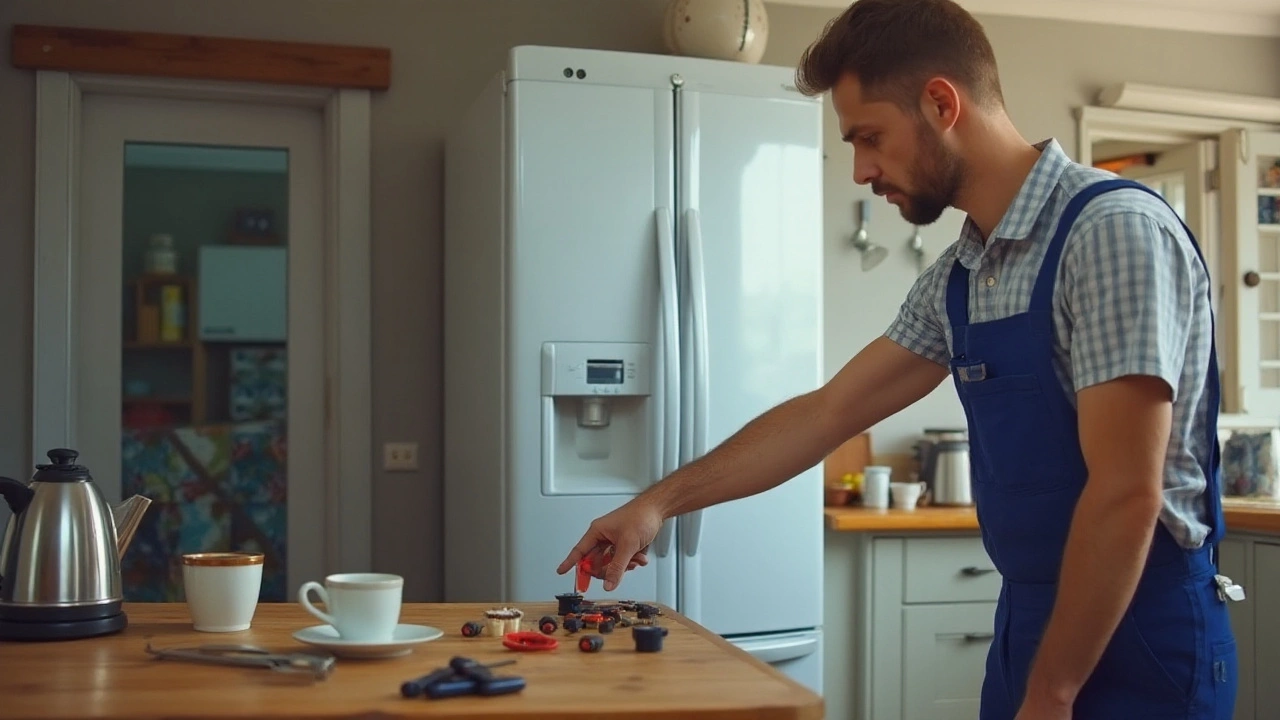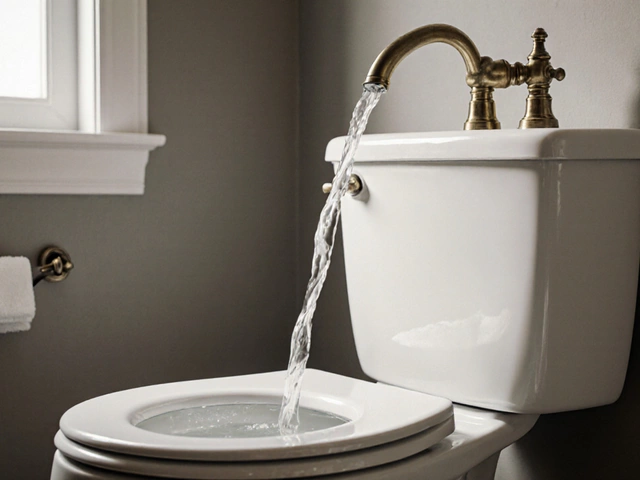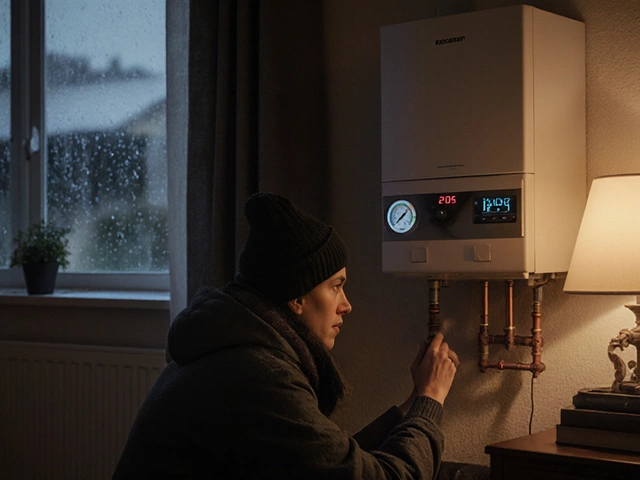Have you ever wondered if your fridge is trying to tell you something? Yeah, they can't speak, but they sure have their ways of sending signals. Let's chat about the sneaky signs that your refrigerator is going on the fritz. No one likes to open their fridge to find lukewarm milk or wilting veggies, right?
The first thing you might notice is noise. If your fridge starts sounding like a small jet engine, that's a red flag. Most fridges hum along quietly, so when they don't, it's time to pay attention. Constant loud buzzing or unfamiliar clanking noises could mean the compressor or fans are struggling.
Another big clue is temperature. Your fridge should be cool, not room temp. If it feels like it's having a sauna day, something's up. Check if the thermostat dial got bumped or if there are major dust-bunnies clogging the rear coils. Keep those coils clean—your fridge will thank you by running efficiently!
- Recognizing the Unusual Noises
- Warm Fridge, Hot Problem
- Spoilage Clues: Food Going Bad Fast
- Ice Build-Up and What It Means
- Paying Attention to Energy Bills
- Simple Fixes and When to Call the Pros
Recognizing the Unusual Noises
Is your fridge starting to develop a mind of its own with all those weird noises? Let’s break down what those sounds might mean. Your refrigerator is full of moving parts, and whether it's buzzing, clanking, or popping, each noise can indicate a different issue.
Buzzing Noises
A constant buzz can be annoying, but it's often your ice maker working overtime. If your fridge doesn’t have one, it might be a sign that the compressor is working too hard. Try cleaning the condenser coils or check for a failing fan motor.
Clanking or Rattling
Did things just get shaky? Loose parts can cause these noises. Check if the fridge is level and ensure there are no objects stuck around the condenser or evaporator fan. Sometimes even that forgotten container can rattle against the walls, causing alarm.
Popping or Cracking Sounds
This might sound ominous, but it’s usually just the plastic parts contracting and expanding with temperature changes. But, if it’s unusually loud or frequent, keep an eye out for damage or structural issues inside your fridge.
To sum up, most unusual noises might be harmless quirks of your handy fridge. But persistent or loud changes are your cue to act. Tending to these sounds early with a bit of basic appliance maintenance keeps your fridge running smoothly. And remember, if things get too complicated, it might be time to call in the fridge repair pros!
| Noise Type | Possible Cause |
|---|---|
| Buzzing | Ice Maker or Compressor |
| Clanking | Loose Parts or Objects Inside |
| Popping | Temperature Changes |
Warm Fridge, Hot Problem
Alright, so you swung open the fridge door, and instead of a blast of cool air, it's more like a mild breeze. What's going on? A warm fridge means a refrigerator issue that needs your attention pronto before food spoilage starts wreaking havoc.
First off, check the thermostat settings. Sometimes, it just gets bumped or adjusted by mistake. Make sure it's set to the correct temperature, ideally between 1.7°C to 3.3°C for the fridge compartment. The freezer should be at around -18°C.
Inspect the Door Seals
You'd be surprised how often door seals, a.k.a. gaskets, cause problems. If they're cracked or not sealing properly, cold air escapes, and the fridge works overtime to maintain the temperature. A quick test? Slide a piece of paper between the door and the fridge. If it slips out easily, the seals might need replacing.
Ventilation and Airflow
Another common cause is blocked airflow. Fridges need space to breathe. Move them away from the wall a bit, and make sure the vents inside the fridge aren't blocked by containers or overstuffed food. Good air circulation is key to keeping things chilly.
Is the Evaporator Fan Functioning?
The evaporator fan is crucial for cooling. Listen for it when the fridge is running. If it's silent or making strange noises, it might have an issue. This is not something you want to ignore, as it can be a clear sign of a bigger fridge repair need.
| Component | Temperature Effect |
|---|---|
| Thermostat Setting | Cools or warms based on setting |
| Door Seal | Allows cold air to escape |
| Fan | Distributes cold air evenly |
If all these checks don't solve the problem, it could be time to call in a pro. They'll have the tools and expertise to diagnose deeper issues, like a failing compressor or refrigerant leaks. Remember, routine appliance maintenance can prevent most problems before they escalate.
Spoilage Clues: Food Going Bad Fast
We all know that feeling—when you open the fridge and get hit by the smell of something that used to be food. If your grub is turning sour or getting moldy sooner than it should, it might mean your refrigerator isn't doing its job. It's supposed to keep your food cold and fresh, right?
Let's start with checking the temperature. Your fridge's main gig is to keep internal temps between 0 to 5 degrees Celsius. If it's failing at that, no wonder your groceries are crying for help. Get a fridge thermometer and make sure your climate control is on point.
Another clue is condensation. Ever notice water droplets on your food containers or fridge walls? That's the fridge equivalent of sweating, and it’s not good. It could be a sign the seal on your fridge door is busted, letting warm air sneak in and spoil the party.
Spotting Signs of Poor Cooling
- Milk goes off way before the expiration date.
- Veggies become more suitable for a compost bin rather than a salad.
- Frost-free freezer has a mini blizzard inside.
Weird smells, too, aren't just annoying. They might indicate your fridge is struggling to circulate air properly or the appliance's insulation is compromised.
What to Do
- Check fridge settings. Make sure they are set at the manufacturer-recommended levels.
- Inspect the door seal. Is it closing tight? A quick test: Stick a dollar bill halfway in and close the door. If it slips out, the seal's not working.
- Look for frost build-up in the freezer and clear it out if needed.
- Consider rearranging food for better air circulation. Don't block the vents!
Catching these fridge woes early can save you a small fortune and prevent countless trips to the grocery store. So, keep an eye—and a nose—out for these spoilage clues!

Ice Build-Up and What It Means
Ever opened your freezer and thought you misplaced Christmas with all that frost? Ice build-up can be more than just a frozen surprise; it's a signal that your fridge might be having a minor meltdown. Let's break down why this happens and what you can do about it.
First off, ice build-up often means your fridge isn't sealing properly. Check the door gaskets—they're those rubbery strips around the edge of the door. If they're cracked or not sealing tight, it lets in warm air, which causes condensation to freeze and pile up. This is a common culprit that can be swiftly fixed with a gasket replacement.
Another reason might be a faulty defrost system. In frost-free fridges, which are the majority these days, a defrost heater occasionally melts frost build-up on the evaporator coils. If this system fails, ice will accumulate. In such cases, it's probably best to call in a pro to take a look, as tinkering inside a fridge can lead to more troubles if you're not careful.
The Troubles with Drainage
Sometimes, clogged drains can lead to ice too. Meltwater should flow down the drain line and out, but if blocked, it looks for any path, often turning to ice. You can try to clear it with a warm, soapy water pour—using a funnel helps get it right where you need.
Check these most likely reasons if you spot ice build-up. Attending to this issue quickly not only keeps your food in good condition but also saves on energy use, since your fridge isn't working extra hard to keep things cool.
| Common Ice Build-Up Causes | Suggested Solutions |
|---|---|
| Door not sealing | Inspect and replace gaskets |
| Faulty defrost heater | Consult appliance repair |
| Clogged drainage | Unclog with warm water flood |
Paying Attention to Energy Bills
Ever notice a sudden spike in your energy bill and wonder if your fridge is the culprit? It might just be. An inefficient refrigerator can guzzle electricity like a dehydrated camel at an oasis. Let's dig into how you can identify if your fridge is affecting those bills.
First up, let's talk about what's considered "normal". A newer, energy-efficient fridge typically uses between 100 to 800 kWh each year. If your bill suddenly shoots up without any new appliances being added, it might be time to scrutinize your trusty food-keeper.
Watch for Signs of Overworking
If the fridge is running all the time or you feel unusual heat coming from the back or sides, it may be overworking. The likely suspects? Dusty coils, a faulty thermostat, or even a poorly sealed door that lets cool air escape.
Simple Checks You Can Do
- Inspect the door seals. Something as simple as a worn seal can make the motor work harder, using more power.
- Ensure that the fridge coil area is clean. Dust and debris can cause energy consumption to skyrocket.
- Monitor temperatures inside using a reliable thermometer—ideally, the fridge should be around 37°F (3°C) and the freezer should be 0°F (-18°C).
Performing these checks can resolve common issues that hike up energy consumption.
When to Consider Replacement
If your fridge is older than 15 years, it may be time to replace it with a more energy-efficient model. Here’s a quick look at potential savings:
| Fridge Age | Yearly Energy Use (kWh) | Potential Savings (% with new model) |
|---|---|---|
| 10-15 years | 1,200 kWh | 35% |
| >15 years | 1,800 kWh | 50% |
Switching to a newer model can save you on energy bills in the long run. Remember, sometimes spending a little now can save you a lot annually.
Keeping an eye on your energy bills isn't just about saving money—it's also a good way to gauge your fridge's health. A little attention now can prevent bigger headaches later.
Simple Fixes and When to Call the Pros
Sometimes, your fridge repair issues might be things you can tackle on your own. Let's tackle some easy fixes before you break open the piggy bank for a pro.
Quick DIY Fixes
Start with a humble cleaning. Dust and grime built up on the coils are secret assassins for your fridge's efficiency. Roll up your sleeves, grab a vacuum with a brush attachment, and clean those coils—typically found on the bottom or back.
Check the thermostat. It's not uncommon for it to accidentally get nudged. Set it between 3-5 degrees Celsius to maintain optimal cooling.
Gasket check time! That's the rubber seal lining the door. If it's cracked or not sitting properly, you'll lose cool air faster than a teenager loses interest. Test it by closing the door on a slip of paper. If you can pull it out easily, the gasket's likely the culprit.
When to Call in the Pros
Not every fridge repair can be handled with a little elbow grease. Sometimes, you need the big guns. For instance, if your fridge is constantly cycling on and off, that's a thermostat or compressor problem best left to the experts.
Water pooling inside or outside the fridge? It may indicate a clogged defrost drain or a busted drain pan. These can quickly turn messy, so better let a professional handle it.
How about the mysterious case of rising energy bills despite no increase in usage? If your fridge runs overtime yet feels like a warm breeze, you might need a new compressor or condenser coils.
To save you time and hassle, check if your fridge is still under warranty before contacting a repair service. Here’s a quick look at average repair costs in a neat table:
| Repair Type | Average Cost (NZD) |
|---|---|
| Thermostat Replacement | $150 - $250 |
| Compressor Repair | $300 - $500 |
| Gasket Replacement | $100 - $200 |
The goal is to catch issues early to avoid major down-the-line repairs. So, remember, a bit of prevention and a timely handshake with a pro can keep your refrigerator running like a champ!




